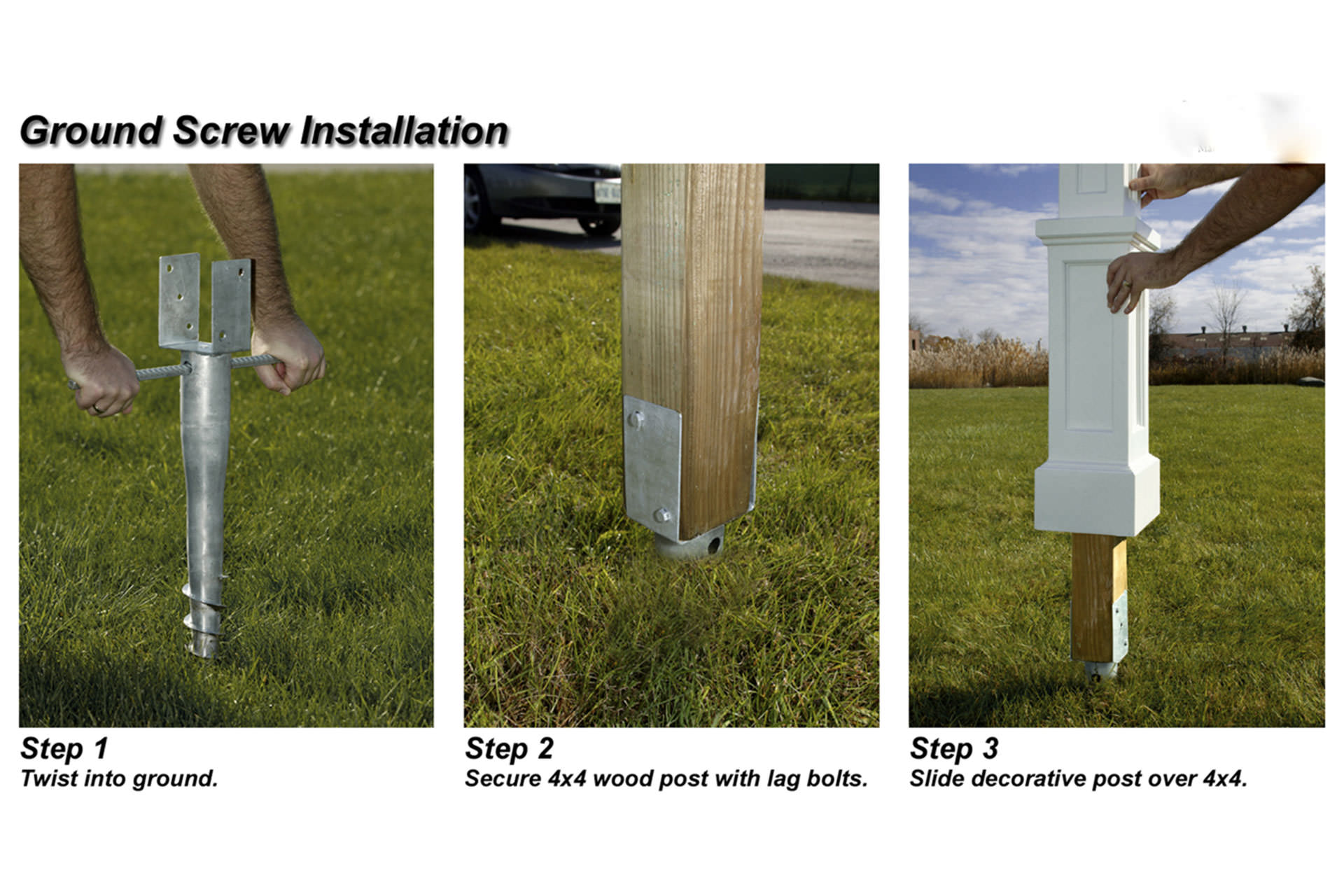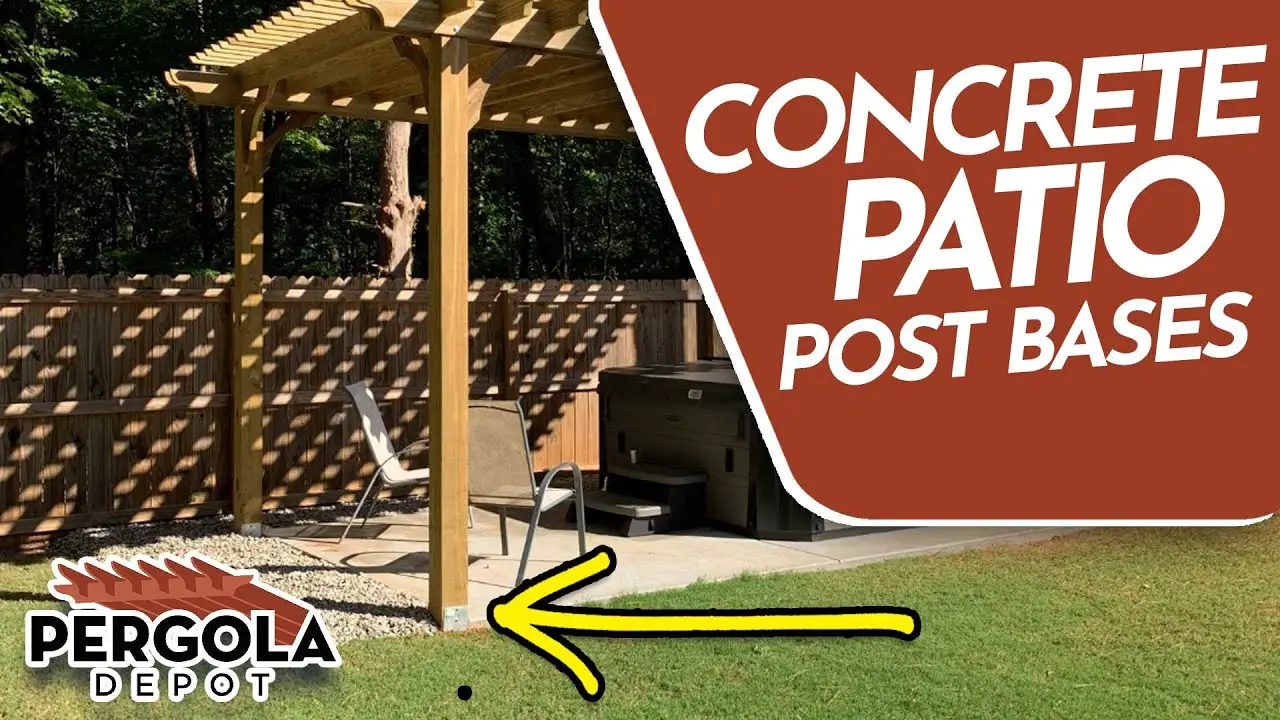How to anchor pergola to concrete? To anchor a pergola to concrete, you can use concrete anchors or wedge anchors. Simply drill holes into the concrete, insert the anchors, and secure the pergola with screws or bolts.
When constructing a pergola, one important step is to anchor it securely to ensure stability and durability. Anchoring a pergola to concrete is a popular method that offers stability and prevents the structure from shifting or being affected by strong winds.
There are a few different options you can consider, such as using concrete anchors or wedge anchors. This article will guide you through the process of anchoring a pergola to concrete, providing step-by-step instructions and helpful tips to ensure a successful installation. By following these guidelines, you can easily anchor your pergola to concrete and enjoy a strong and secure structure in your outdoor space.

Credit: www.shadefxcanopies.com
Understanding The Importance Of Anchoring A Pergola To Concrete
A pergola can be a beautiful addition to any outdoor space, providing shade, elegance, and a place to relax. However, it’s essential to understand the importance of anchoring your pergola to concrete to ensure its structural integrity, stability, and most importantly, your safety.
The Structural Integrity Of A Pergola
- Anchoring a pergola to concrete plays a crucial role in maintaining its structural integrity. When properly anchored, the pergola becomes more resistant to external forces, such as wind, rain, or even accidental bumps.
- Without proper anchoring, the pergola may become unstable and prone to damage or collapse, causing potential harm to anyone near it.
Ensuring Stability And Safety
- Anchoring a pergola to concrete helps to ensure stability and safety. Concrete provides a solid and durable foundation that can hold the weight of the pergola and withstand various environmental conditions.
- Properly anchored pergolas are less likely to sway, wobble, or shift, providing a secure and comfortable space for you and your loved ones to enjoy.
Benefits Of Anchoring To Concrete
- Enhanced durability: Anchoring a pergola to concrete extends its lifespan by preventing excessive wear and tear due to movement or instability.
- Added strength: By securing the pergola to a concrete base, it becomes more resistant to extreme weather conditions, such as strong winds, heavy rainfall, or even seismic activity.
- Increased safety: Anchoring ensures the safety of those using the pergola and anyone nearby. It reduces the risk of accidents or injuries caused by a shaky or collapsing structure.
By fully understanding the importance of properly anchoring a pergola to concrete, you can ensure its stability, longevity, and most importantly, the safety of everyone who enjoys the outdoor space. So, before installing your pergola, make sure to invest the time and effort needed to secure it to a concrete foundation effectively.
Choosing The Right Anchoring Method For Your Pergola
A pergola is a beautiful addition to any outdoor space, providing shade and a relaxing atmosphere. But in order to ensure that your pergola stays secure and stable, it’s important to choose the right anchoring method. There are several factors to consider when making this decision, including the location and climate conditions, the size and weight of the pergola, and whether it will be a permanent or temporary installation.
Let’s explore these factors in more detail.
Factors To Consider In Selecting The Anchoring Method
When it comes to anchoring your pergola to concrete, there are a few key factors that you should take into account:
- Location and climate conditions: The first thing you should consider is the location and climate conditions of your outdoor space. Is it prone to strong winds or heavy rains? Is it in an area with frequent earthquakes? Understanding these factors will help you determine the level of stability that you will need for your pergola.
- Size and weight of the pergola: The size and weight of your pergola are also important considerations. A larger and heavier pergola will require a more robust anchoring method to provide the necessary support. On the other hand, a smaller and lighter pergola may be adequately anchored with a less heavy-duty method.
- Permanent or temporary installation: Another factor to consider is whether you want your pergola to be a permanent or temporary installation. If it’s a permanent structure, you will want to choose an anchoring method that provides long-lasting stability. For a temporary installation, you may opt for a less permanent anchoring method that allows for easy removal.
Different Types Of Anchoring Methods
Once you have considered these factors, you can then explore the different types of anchoring methods available for securing your pergola to concrete:
- Post brackets: Post brackets are commonly used to anchor pergolas to concrete. They provide a secure connection between the pergola posts and the concrete surface. These brackets are typically made of metal and are easy to install.
- Anchor bolts: Anchor bolts are another option for anchoring pergolas to concrete. These heavy-duty bolts are drilled directly into the concrete surface and provide a strong anchor point for the pergola posts. This method offers excellent stability and is ideal for larger and heavier pergolas.
- Concrete anchors: Concrete anchors, also known as wedge anchors or expansion anchors, are versatile and reliable. They are inserted into pre-drilled holes in the concrete and expand when tightened, creating a secure connection between the pergola and the concrete surface. Concrete anchors are suitable for a wide range of pergola sizes and weights.
By considering these factors and understanding the different anchoring methods available, you can choose the right option to ensure that your pergola stays firmly in place for years to come. Remember to follow the manufacturer’s instructions and consult a professional if needed to ensure proper installation and safety.
Gathering The Necessary Tools And Materials
Tools Required For Anchoring:
To successfully anchor a pergola to concrete, you’ll need a few essential tools that will make the job easier and more efficient. Here are the must-have tools for this project:
- Hammer drill: A hammer drill is a powerful tool that can create holes in concrete surfaces. It’s necessary for drilling into the concrete to secure the anchors or bolts.
- Masonry drill bit: You’ll require a masonry drill bit that is specifically designed for drilling into concrete. These drill bits are strong and durable, ensuring accurate and efficient drilling.
- Wrench or socket set: A wrench or socket set is essential for tightening nuts and bolts during the anchoring process. Make sure you have the appropriate sizes to fit the anchors or bolts you’ll be using.
- Level: A level will help ensure that your pergola is straight and level once anchored. It’s important for achieving stability and a visually appealing result.
- Measuring tape: Accurate measurements are crucial when anchoring a pergola to concrete. A measuring tape will help you determine the precise placement and spacing of the anchors or bolts.
- Safety equipment: Safety should always be a priority when working with power tools and concrete. Equip yourself with safety goggles, ear protection, and gloves to protect yourself during the project.
Materials Needed For The Anchoring Process:
Besides the necessary tools, you’ll also need specific materials to anchor your pergola securely. Here are the materials you’ll require:
- Anchors or bolts: Anchors or bolts are essential for securing your pergola to the concrete. Choose high-quality anchors or bolts that are suitable for attaching heavy structures to concrete surfaces.
- Concrete mix: If the existing concrete doesn’t have a solid base or if you’re starting from scratch, you’ll need a concrete mix to create a stable foundation for the pergola posts. Ensure you follow the manufacturer’s instructions for mixing and pouring the concrete properly.
- Rebar (if required): In some cases, additional reinforcement may be necessary to increase the strength and stability of the concrete foundation. Rebar, or reinforced steel bars, can be added to the concrete mix for added support.
- Shims (if needed): Shims are small wedges that can help level the pergola and compensate for any unevenness in the concrete surface. If you encounter discrepancies in the concrete, shims can be used to achieve a level installation.
- Waterproofing sealant: To protect your pergola from moisture damage, apply a waterproofing sealant to the concrete base. This will help extend the longevity of your pergola and prevent any potential water-related issues.
Now that you have a good understanding of the necessary tools and materials for anchoring a pergola to concrete, let’s dive into the step-by-step process of completing this project with success.
Preparing The Concrete Surface
Inspecting the concrete for cracks or damage:
- Check the entire concrete surface for any cracks or damage that might impact the stability of the pergola.
- Look for any signs of wear and tear, such as uneven areas or crumbling concrete.
- If you spot any cracks or damage, consider repairing or reinforcing the concrete before proceeding further.
Cleaning the concrete surface:
- Prior to anchoring the pergola, it’s essential to ensure the concrete surface is clean and free from dirt, debris, and grease.
- Sweep or use a leaf blower to remove loose dirt and debris from the area.
- Use a stiff brush or broom to scrub the surface, removing any stubborn dirt or stains.
Removing dirt, debris, and grease:
- For stubborn dirt or grease stains, use a degreaser or a mixture of water and mild detergent.
- Scrub the affected areas with a brush, focusing on removing any residue that could interfere with the anchor’s grip.
Power washing if necessary:
- If the concrete surface is heavily soiled or has hard-to-remove stains, consider power washing.
- Rent or borrow a power washer, ensuring that it’s suitable for use on concrete surfaces.
- Follow the manufacturer’s instructions and guidelines for power washing to avoid causing damage to the concrete.
Determining the anchor placement and layout:
- Before drilling into the concrete, carefully plan the placement and layout of the anchors.
- Consider the size and design of the pergola, as well as any specific guidelines or recommendations provided by the manufacturer.
- Ensure that the anchor placement will provide optimum support and stability for the pergola structure.
Measuring and marking the locations:
- Measure and mark the desired anchor locations on the concrete surface.
- Use a tape measure and a marker or chalk to accurately indicate where the anchors will be installed.
- Double-check the measurements and make any necessary adjustments.
Considerations for post and beam alignment:
- Ensure that the post and beam alignment is in line with the overall design and layout of the pergola.
- Take into account any specific instructions or guidelines provided by the manufacturer.
- Verify that the anchor placements will allow for proper alignment and secure attachment of the pergola components.
Preparing the concrete surface is a vital step in anchoring a pergola securely. By inspecting for cracks or damage, cleaning the surface, and removing dirt, debris, and grease, you create a solid foundation for the pergola structure. Power washing can be useful for heavily soiled or stained surfaces.
Careful planning of anchor placement and alignment ensures optimum support and stability for your pergola. Measure and mark the locations accurately before proceeding with the installation.
Anchoring The Pergola To Concrete
When it comes to securing your pergola to a concrete surface, there are several methods you can use. Each method has its own steps and considerations to ensure a sturdy and durable anchor. Here, we will guide you through the process, step by step, for each method.
Attaching Post Brackets
- Position the post brackets on the concrete surface where you want your pergola posts to be secured.
- Mark the hole locations on the concrete using a marker or pencil.
- Use a hammer drill to create the necessary holes in the concrete.
- Insert the concrete anchors into the holes.
- Place the post brackets over the anchors and secure them with screws.
Drilling Anchor Bolt Holes
- Determine the placement of your pergola posts and mark the hole locations on the concrete.
- Use a hammer drill with a masonry bit to drill the anchor bolt holes.
- Clean out the holes by blowing away the dust and debris.
- Insert the anchor bolts into the holes, making sure they are level with the concrete surface.
Installing Concrete Anchors
- Determine the location for your pergola posts and mark the spots on the concrete.
- Use a hammer drill to create holes for the concrete anchors.
- Clean out the holes to remove any debris.
- Insert the concrete anchors into the holes, making sure they are flush with the surface.
- Use a wrench to tighten the anchors securely.
Using Expansion Anchors
- Determine the placement of your pergola posts and mark the spots on the concrete.
- Use a hammer drill with a masonry bit to create holes for the expansion anchors.
- Clean out the holes thoroughly.
- Insert the expansion anchors into the holes, making sure they are flush with the surface.
- Tighten the expansion anchors with a wrench until they have a secure grip.
Tips For Ensuring Proper Alignment And Levelness
- Use a level to ensure that your pergola posts are plumb and level before securing them to the concrete.
- Double-check the measurements and positions to ensure proper alignment.
- Make adjustments as needed to ensure everything is in place before finalizing the anchoring process.
Securing The Posts And Beams To The Anchors
- Once your anchors are in place, position the pergola posts and beams over them.
- Align the posts and beams with the brackets or anchor bolts.
- Secure the posts and beams to the brackets or anchor bolts using appropriate screws or bolts.
- Make sure the connections are tight and secure.
Tightening Anchor Bolts
- If you have used anchor bolts for your pergola, make sure to tighten them securely.
- Use a wrench or socket wrench to tighten the bolts until they are snug.
- Avoid over-tightening, as it may damage the concrete or the anchor bolts.
Adjusting And Aligning The Pergola Components
- After securing the posts and beams, take a final look at the overall alignment and levelness of your pergola.
- Make any necessary adjustments to ensure everything is straight and even.
- Check the measurements to ensure accuracy and symmetry.
Now that you have a step-by-step guide for anchoring your pergola to concrete, you can confidently proceed with the installation. By following these instructions and paying attention to detail, you can ensure a sturdy and long-lasting structure that enhances your outdoor space.
Frequently Asked Questions For How To Anchor Pergola To Concrete
How Do You Anchor A Pergola To Concrete?
To anchor a pergola to concrete, you can use anchor bolts, concrete screws, or expansion anchors. Drill holes into the concrete, insert the anchors, and tighten them. Follow the manufacturer’s instructions and make sure the pergola is properly secured for safety.
What Tools Are Needed To Anchor A Pergola To Concrete?
To anchor a pergola to concrete, you will need a drill with a masonry bit, a hammer drill for harder concrete, wrenches or a socket set, and the appropriate anchors. Additionally, you may need a level, measuring tape, and safety goggles for the installation process.
Can You Anchor A Pergola To An Existing Concrete Slab?
Yes, you can anchor a pergola to an existing concrete slab. Use an appropriate anchor system, such as anchor bolts or expansion anchors, to secure the pergola to the concrete slab. Ensure the existing slab is strong enough to support the weight and forces applied by the pergola.
How Deep Should Anchor Bolts Be For A Pergola?
Anchor bolts for a pergola should be embedded into the concrete at least 4 inches deep. This depth provides sufficient stability and ensures a proper connection between the pergola and the concrete. Follow the manufacturer’s recommendations and local building codes for specific requirements in your area.
Can I Use Adhesive To Anchor A Pergola To Concrete?
Using adhesive alone is not recommended to anchor a pergola to concrete. Adhesive is not designed to withstand the forces and weight that a pergola exerts. For a secure and safe installation, it is best to use anchor bolts, concrete screws, or expansion anchors specifically designed for this purpose.
How Many Anchor Points Are Needed For A Pergola On Concrete?
The number of anchor points needed for a pergola on concrete depends on the size and design of the pergola, as well as the local building codes. As a general guideline, it is recommended to have at least four anchor points evenly distributed to provide stability and prevent any wobbling or shifting of the structure.
Conclusion
To summarize, anchoring your pergola to concrete is a vital step in ensuring its stability and longevity. By following the proper techniques, you can secure your pergola firmly and enhance its overall aesthetic appeal. First, assess the location and measurements to determine the number of anchor points required.
Next, choose the appropriate anchoring method, such as wedge anchors or concrete screws, based on your pergola’s design and weight. Remember to pre-drill holes to prevent cracks in the concrete. Proper installation and regular maintenance, including inspecting and tightening the anchors periodically, will guarantee the safety and durability of your pergola.
With the valuable information presented in this guide, you can confidently anchor your pergola to concrete and create a stylish and functional outdoor space for years to come. Happy pergola building!

